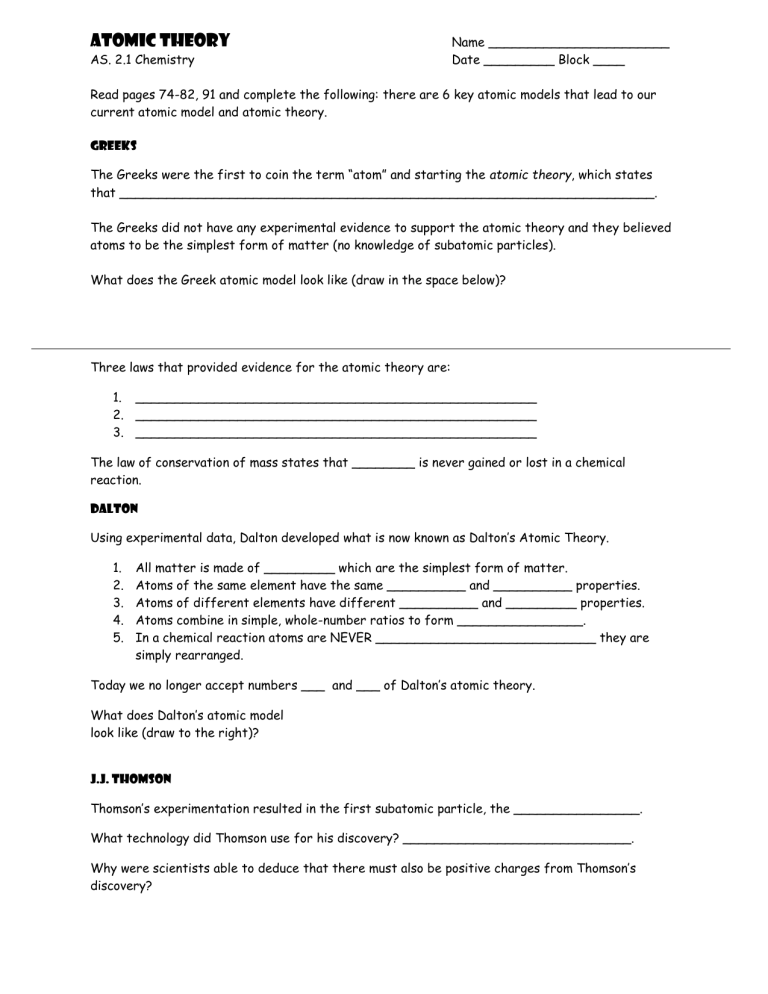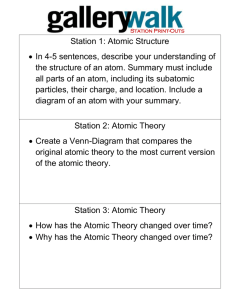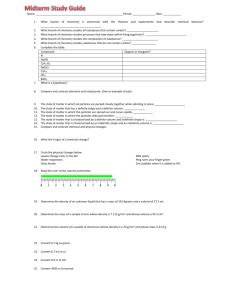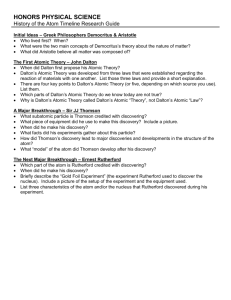Atomic Theory Name AS. 2.1 Chemistry Date ______ Block ____

Atomic Theory
AS. 2.1 Chemistry
Name _______________________
Date _________ Block ____
Read pages 74-82, 91 and complete the following: there are 6 key atomic models that lead to our current atomic model and atomic theory.
Greeks
The Greeks were the first to coin the term “atom” and starting the atomic theory, which states that ____________________________________________________________________.
The Greeks did not have any experimental evidence to support the atomic theory and they believed atoms to be the simplest form of matter (no knowledge of subatomic particles).
What does the Greek atomic model look like (draw in the space below)?
Three laws that provided evidence for the atomic theory are:
1.
___________________________________________________
2.
___________________________________________________
3.
___________________________________________________
The law of conservation of mass states that ________ is never gained or lost in a chemical reaction.
Dalton
Using experimental data, Dalton developed what is now known as Dalton’s Atomic Theory.
1.
All matter is made of _________ which are the simplest form of matter.
2.
Atoms of the same element have the same __________ and __________ properties.
3.
Atoms of different elements have different __________ and _________ properties.
4.
Atoms combine in simple, whole-number ratios to form ________________.
5.
In a chemical reaction atoms are NEVER ____________________________ they are simply rearranged.
Today we no longer accept numbers ___ and ___ of Dalton’s atomic theory.
What does Dalton’s atomic model look like (draw to the right)?
J.J. Thomson
Thomson’s experimentation resulted in the first subatomic particle, the ________________.
What technology did Thomson use for his discovery? _____________________________.
Why were scientists able to deduce that there must also be positive charges from Thomson’s discovery?
What does JJ Thomson’s atomic model look like (draw to the right)?
Ernest Rutherford
Rutherford discovered the ____________________ in his famous experiment known as the Gold
Foil Experiment.
A beam of alpha particles, ______________ charged particles, was directed at gold foil.
Rutherford found that _______ alpha particles made it through the foil, which is what he expected, however, a small number of particles ____________. He concluded that there must be a very dense _____________ charged particle in the atom, now known as the _______________.
It is in the nucleus where almost all _________ of an atom is located in a small fraction of space in the atom.
What does Rutherford’s atomic model look like (draw to the right)?
James Chadwick
Chadwick discovered the _____________ which was added to the ____________ of an atom.
Niels Bohr
According to Bohr’s atomic model, electrons can be only certain _____________ from the nucleus and are found in specific ____________ levels. An electron closest to the nucleus is in its
_________________ and an electron furthest is in its ____________________ because electrons prefer to be close to the nucleus. Electrons are NEVER found between _____________.
Bohr says that we can know the exact location of ___________ within an energy level.
Current Atomic Theory
We accept most of Bohr’s atomic model, there is just once key difference: WE NOW KNOW THAT
WE CANNOT KNOW THE EXACT LOCATION OF EVERY ELECTRON IN AN ATOM, BUT WE CAN
PREDICT WHERETHEY ARE. In conclusion, our current atomic theory states:
All matter is composed of atoms
Atoms are never created or destroyed
Atoms of different elements differ in physical and chemical properties
The atom is mostly empty space
There is a dense, positively charged nucleus composed of protons and neutrons at the center of an atom
Electrons orbit the nucleus in specific energy levels
Complete the chart
Symbol Mass (kg)
Proton
Neutron
Electron
Common
Charge
Notation








